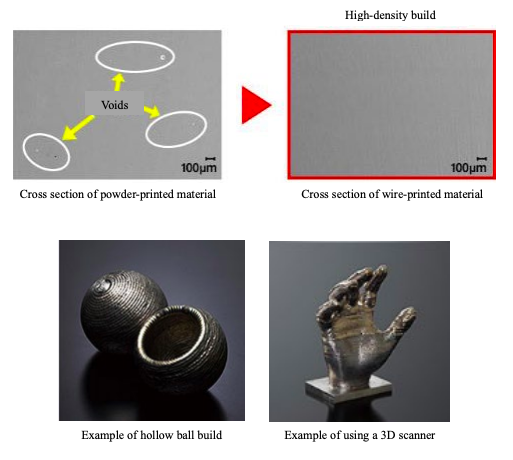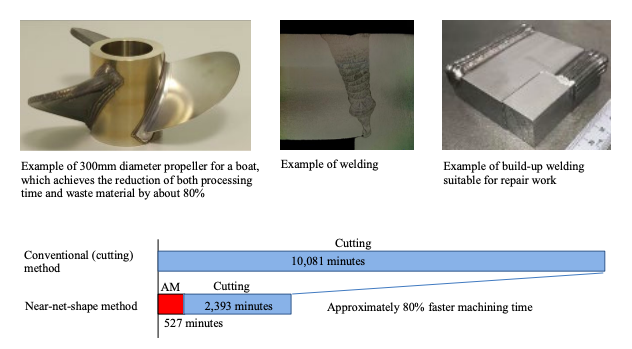On March 1, 2022, Mitsubishi Electric Corporation (TOKYO: 6503) released two models of a new directed energy deposition (DED) 3D printer dubbed the AZ600. The Japanese giant labeled the new line as “a world’s first, delivers stable, high-quality 3D printing,” qualifying “world’s first” by noting, “As of February 24, 2022, according to Mitsubishi Electric’s research.”
The technology melts welding wire with a laser beam to 3D print metal structures using 5-axis spatial control. While the AZ600-F20 will feature a 2kW oscillator, the AZ600-F40’s will be 4kW. Both have a work volume of Φ500×500mm. It’s interesting to note that the company explored a five-axis polymer 3D printing technology way back in 2016. This was followed up in 2018 with the release of a “dot forming” technology, which was also a form of DED. The AZ600 seems to be a descendent of this process.

Metal 3D printed parts. Image courtesy of Mitsubishi Electric.
Mitsubishi Electric highlights its applications for maintenance and repair of parts for the automotive, maritime, and aerospace sectors. Additionally, the firm claims that 3D printing has the potential to reduce energy consumption and material waste in metalworking. The company notes that by 3D printing a part to near-net-shape and machining to final specifications it’s possible to reduce machining time and waste by about 80 percent compared to traditional methods. This number was arrived at when producing a 300mm diameter marine propeller.

Image courtesy of Mitsubishi Electric.
Mitsubishi is actually competing with itself in this case, as Mitsubishi Heavy Industries already has a DED line. However, that division’s technology relies on blown powder, which can be more expensive and more difficult to control and handle than wire feedstock. In addition, typical wire feedstock machines rely on an arc welding method, which limits accuracy. Mitsubishi Electric attempts to overcome these limitations by applying a laser beam to wire feedstock.

Image courtesy of Mitsubishi Electric.
There’s also Mitsubishi Chemicals, a division of Mitsubishi Corporation that has steadily increased its stake in polymer 3D printing. Mitsubishi Corporation is also separate from Heavy Industries and Electric as one of four independent companies formed after World War II. The fourth is MUFG Bank, the largest bank in Japan.
Though its various divisions may compete with one another, the larger Mitsubishi Group seems to benefit. Wikipedia describes the relationship between the various business entities in the following way:
“Founded by Yatarō Iwasaki in 1870, the Mitsubishi Group historically descended from the Mitsubishi zaibatsu, a unified company which existed from 1870 to 1946. The company was disbanded during the occupation of Japan following World War II. The former constituents of the company continue to share the Mitsubishi brand and trademark. Although the group companies participate in limited business cooperation, most famously through monthly “Friday Conference” executive meetings, they are formally independent and are not under common control. The four main companies in the group are MUFG Bank (the largest bank in Japan), Mitsubishi Corporation (a general trading company), Mitsubishi Electric and Mitsubishi Heavy Industries (both diversified manufacturing companies).”
Perhaps in a follow-up post, we’ll look more closely at how this relationship operates. After all, they have overlapping institutional shareholders. For example, Sumitomo Mitsui Trust Asset Management Co., Ltd. owns 3.99 percent of Mitsubishi Heavy Industries, 3.30 percent of Mitsubishi Corporation, 3.7 percent of Mitsubishi Electric, and 3.43 percent of MUFG Bank.
According to the “DED and Large-Format Additive Manufacturing Markets: 2021-2030” report from SmarTech Analysis, the DED and large-format 3D printing sector will be worth $739 million in 2026. Mitsubishi seems to be tackling this sector on multiple fronts. Potential customers can look forward to the AZ600 series, which will make its public debut at the “Additive Manufacturing Expo” from March 16-18 at Tokyo Big Sight.
Subscribe to Our Email Newsletter
Stay up-to-date on all the latest news from the 3D printing industry and receive information and offers from third party vendors.
You May Also Like
Precision at the Microscale: UK Researchers Advance Medical Devices with BMF’s 3D Printing Tech
University of Nottingham researchers are using Boston Micro Fabrication‘s (BMF) 3D printing technology to develop medical devices that improve compatibility with human tissue. Funded by a UK grant, this project...
3D Printing Webinar and Event Roundup: April 21, 2024
It’s another busy week of webinars and events, starting with Hannover Messe in Germany and continuing with Metalcasting Congress, Chinaplas, TechBlick’s Innovation Festival, and more. Stratasys continues its advanced training...
3D Printing Webinar and Event Roundup: March 17, 2024
It’s another busy week of webinars and events, including SALMED 2024 and AM Forum in Berlin. Stratasys continues its in-person training and is offering two webinars, ASTM is holding a...
3D Printed Micro Antenna is 15% Smaller and 6X Lighter
Horizon Microtechnologies has achieved success in creating a high-frequency D-Band horn antenna through micro 3D printing. However, this achievement did not rely solely on 3D printing; it involved a combination...





























